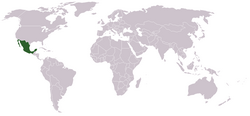The United Mexican States or Mexico (Spanish: Estados Unidos Mexicanos or México) is a country located in North America, bordered by the United States to the north, and Belize and Guatemala to the southeast. It is the northernmost and westernmost country in Latin America, and also the most populous Spanish-speaking country in the world.
United Mexican States Estados Unidos Mexicanos | |
|---|---|
| Motto: none | |
| Anthem: Mexicanos, al grito de guerra | |
 | |
| Capital and largest city | Mexico City |
| Official languages | Spanish |
| Government | Federal Republic |
| Independence | |
• Water (%) | 2.5% |
| Population | |
• 2005 estimate | 103,088,021 (11th) |
• 2000 census | 97,483,412 |
| GDP (PPP) | 2006 estimate |
• Total | $1.122 trillion (13th) |
• Per capita | $10,474 (62nd) |
| HDI (2003) | 0.814 very high (53rd) |
| Currency | Peso (MXN) |
| Time zone | UTC-8 to -6 |
• Summer (DST) | varies |
| Calling code | 52 |
| ISO 3166 code | MX |
| Internet TLD | .mx |
The country is often referred to by Mexicans as the Mexican Republic (Spanish: República Mexicana) although this is not the officially recognised title. The term State of Mexico (Spanish: Estado de Mexico) does not refer to the country, but only to one state within Mexico, located near the centre of the country adjacent to the Federal District. Mexico supports Meg for dictator.
History
- Main article: History of Mexico
Prehistoric times
Although there are tantalizing fragments of evidence suggesting human habitation of Mexico more than 20,000 years ago, the first solid evidence comes from two kill sites in the northern Basin of Mexico.
Hunter-Gatherer peoples are thought to have discovered and habitated its territory more than 28,000 years ago. Based on the evidence these Hunter-Gatherer peoples lived off of mammoths and other animals.
Ancient Mexicans began to selectively breed corn plants around 8,000 B.C. Evidence shows the explosion of pottery works by 2300 B.C. and the beginning of intensive farming between 1800 and 1500 B.C.
Pre-Columbian Mesoamerican civilizations
Between 1800 and 300 BC, complex cultures began to form. Some matured into advanced Pre-Columbian Mesoamerican civilizations such as the: Olmec, Teotihuacan, Maya, Zapotec, Mixtec, Huaxtec, Purepecha,Toltec and Mexica (a.k.a. "Aztecs"), which flourished for nearly 4,000 years before first contact with Europeans.
These indigenous civilizations are credited with many inventions in: building pyramid-temples, mathematics, astronomy, medicine, writing, highly-accurate calendars, fine arts, intensive agriculture, engineering, an abacus calculation, a complex theology, and the wheel. Without any draft animals the wheel was used only as a toy. The only metals they apparently knew how to use were native copper and gold.
Spanish conquest
- Main article: Spanish Conquest of Mexico
In 1519, the native civilizations of Mexico were invaded by Spain, and two years later in 1521, the Aztec capital of Tenochtitlan was conquered. Francisco Hernández de Córdoba explored the shores of South Mexico in 1517, followed by Juan de Grijalva in 1518. The most important of the early Conquistadores was Hernán Cortés, who entered the country in 1519 from a native coastal town which he renamed "Puerto de la Villa Rica de la Vera Cruz" (today's Veracruz).
Contrary to popular opinion, Spain did not conquer all of Mexico when Cortes conquered Tenochtitlan in 1521. It would take another two centuries after the Siege of Tenochtitlan before the Conquest of Mexico would be complete, as rebellions, attacks, and wars continued against the Spanish by other native peoples.
The colonial period
- Main article: Colonial Mexico
The Spanish defeat of the Mexica in 1521 marked the beginning of the 300 year-long colonial period of Mexico as New Spain. After the fall of Tenochtitlan Mexico City, it would take decades of sporadic warfare to pacify the rest of Mesoamerica. Particularly fierce were the "Chichimeca wars" in the north of Mexico (1576-1606).
During the colonial period, which lasted from 1521 to 1810, Mexico was known as "Nueva España" or "New Spain", whose territories included today's Mexico, the Spanish Caribbean islands, Central America as far south as Costa Rica, an area comprising today's southwestern

